Abstract
This research uses real options analysis (ROA) to examine a lender’s conversion option in a mezzanine debt for a sustainable infrastructure project. We examine a transport infrastructure case in Medellin, Colombia, called “Tunel del Oriente” (Eastern tunnel), which meets sustainable criteria to allow the access to credit through a sustainable bond. This study proposes a model to evaluate the right to exercise the conversion option by employing ROA with a binomial approach under the concept of a call option. The underlying assets are based on revenues from the forecast of estimated demand and the alternative sales of carbon credits as the sustainable factor. The results indicated that the financial captured value (FCV), with one as the conversion ratio, could be up to 39.10% of the investment when the lender decides to become a shareholder. Furthermore, the FCV can increase by 6% more if the project sells TonCO2e saved by the sustainable factor, highlighting that the tax benefits are approximately 11% of the FCV if the project is sustainable. Additionally, the option value is 39.09% of the debt amount. Finally, this study demonstrates that project finance using mezzanine debt proves to be an effective and attractive method for any lender wanting to boost profit while supporting stakeholders and the environment with sustainable projects and responsible investment.
1. Introduction
Infrastructure development in Colombia represents economic growth, social welfare, and environmental protection based on innovative and sustainable financing vehicles, such as the employment of mezzanine debt. This study aims to demonstrate the feasibility and expose benefits for lenders and investors within project finance (PF) using mezzanine funding specifically for public-private partnerships (PPPs). This study reviews the literature on the financing of infrastructure projects, the implementation of mezzanine funding, and the evaluation of a project employing the methodology of real options analysis (ROA).
This project also examines the importance of investing responsibly, aligning with the Sustainable Development Goals proposed for 2030. This approach introduces a sustainable factor and investigates the benefits of tax, environmental, and monetary income.
Using mezzanine financing, this study evaluates lender’s option to become a shareholder by providing debt capital through PF schemes. This is accomplished using ROA, by considering the underlying assets that consider the sustainable factor, and by demonstrating the feasibility of innovative and attractive project financing for different investors.
González-Ruiz et al. [1] propose a model alternative of financing incorporating sustainable factors from a mezzanine debt scheme. This model allows a lender to become a shareholder in a timeline depending on the contractual conditions. However, further research was proposed to consider private investments as a topic regarding decision management for a lender to become a shareholder. In this way, this research evaluates sustainable infrastructure projects with mezzanine debt under ROA. Therefore, this study proposes a model to exercise options, demonstrating the public and private sectors’ likelihood of using this type of credit with a sustainable approach.
The remainder of the paper is organized as follows. In Section 2, we review the literature on infrastructure projects, sustainability in infrastructure projects, ROA, and mezzanine financing. In Section 3, we explain the materials and methods used in our research. In Section 4, we discuss the results. Finally, Section 5 presents the conclusions.
2. Literature Review
2.1. Infrastructure Projects
To support economic growth, developing countries must strengthen their infrastructure, especially roads, and this requires financial resources that governments often do not have available because they prioritize investments in other sectors [2].
Governments must ensure economic growth through various infrastructure projects, implementing innovation via new procurement models, for which the primary qualities are large-scale investment, considerable execution duration, and risks in dimensional diversity [3]. From a constructor’s perspective, the main objective of construction projects is to reduce cost and minimize duration while guaranteeing quality [4].
PF for infrastructure projects requires a level of economic support that is only suitable for governments; however, with an increasing demand for annual funds to maintain economic growth, governments are unable to provide the capital for infrastructure projects [5]. Governments must implement new technologies and financial structures to improve countries’ infrastructure, compelling them to use innovative methods that support production and generate social benefits. This generated the development of PPPs [6], which have saved 10–15% of the total cost of infrastructure, including operation [7]. The expected investor profit is between 15% and 20% for equity and between 8% and 10% for debt [8]. However, these return ratios are only reflected during operation and maintenance when the largest amounts of flow are outputs [9]. The relation between equity rate and premium risk is associated with inflation, investment size, construction time, and project organization structure [10]. Some of these factors link to the investors’ interests wherein if the investors cannot track project capital demand, they obtain financing through lenders.
The share of capital invested is generally between 10–30% equity and 70–90% debt [11]. Thus, financial leverage is essential for shareholders because it allows for a reasonable return on capital without making more significant centralized investments in equity. However, sometimes investors have equity in an equivalent proportion to guarantee capital and interest [12]. Thus, optimal capital structure could be reached when accessing proper financing from lenders and their positive valuation about bankruptcy risk [13]. A recent example was during the 2008 financial crisis when PPPs halted operations because banks ceased granting loans [14].
2.2. Sustainability in Infrastructure Projects
At the end of the 20th century, sustainability was defined as the relation between the environment, society, and economy [15]. In 2012, the United Nations published “the future we want” which defines sustainability as “economic, social and human development while facilitating ecosystem conservation, regeneration and restoration and resilience in the face of new and emerging challenges” [16].
Initially, the World Commission on Environment and Development (1987) [17] defined sustainable infrastructure as that which “meets the needs of the present without compromising the ability of future generations to meet their own needs,” or that which integrates the environment, society, and government into infrastructure planning, construction, and operation to address climate change. It is an internationally accepted term related to the iterative relations between social, environmental, and economic factors. Unfortunately, no competent authoritative body has established a definition for the limits of this concept [18]. Therefore, the Inter-American Development Bank provides its definition of sustainable infrastructure, issuing a call for projects to be sustainable from the four perspectives of economic, institutional, societal, and environmental resilience at every stage of development, such as operation, pre-investment, investment, execution, operation, and dismantling [19]. The development of new financing mechanisms aims to include sustainable indicators and factors that fit investors’ interests from an economic perspective. Therefore, new methods, models, and financing mechanisms directed toward process innovation, called green finance, have been developed involving these characteristics [20].
Some emergent mechanisms support and reinforce sustainability in infrastructure projects, such as (1) green bonds. “Green Bonds are fixed income securities issued by governments, development agencies and companies where the use of funds is explicitly designed for projects with positive environmental impact” [21]. Unlike other bonds, green bonds are less affected by sudden movements in the financial market [22]. Other projects include environmental impact bonds, social impact bonds that address the sustainable implementation terms, and (2) community benefit PPPs, a new PF mechanism based on PPPs seeking to include a community-based PPP. Their main goals are delivered with concentrated metrics to the community and local employment, delivering opportunities for economic development and addressing environmental impacts [23].
Shaydurova et al. [22] indicated that bonds in the environmental, societal, and governmental (ESG) relationship are stable and have a defensive behavior, which is attractive to almost all investors. Moreover, lenders can improve economic development while implementing policy with ESG factors, imposing environmental and social standards, and controlling regular borrower compliance [24].
Diaz-Sarachaga et al. [25] concluded that classification and evaluation systems are helpful for developed countries because the main characteristics assessed targeted environments; however, developing countries require concomitant social and economic growth. Hence, these systems are inadequate for South American countries. Furthermore, the authors noted that the best evaluation system for the current circumstances is CEEQUAL international, proposing a four-pillar management for risk planning and estimation. Additionally, sustainability in developing countries for environmental assessment is accomplished in the short- and medium-term [26].
Existing ranking systems for sustainable infrastructure projects are weak because they do not consider flexibility and uncertainty at each project stage [27]. Furthermore, stakeholders set the project scope, and shareholders have more power to make the final decisions [28,29]. Conversely, the standardization of the sustainable criteria of the current array of diverse ranking systems can be transformed into economic benefits or more accessible loans [30]. For environmental protection in infrastructure projects, it is convenient to emphasize reduced CO2 emissions during construction, maintenance, and operation [31]. In addition, further suitable criteria include issues such as climate change, biodiversity, visual and sound pollution, water quality, source conservation, and waste management [32].
2.3. ROA
A project’s value is commonly calculated via the net present value (NPV) on the free cash flow, using the cost of capital as the discount rate. Luehrman [33] indicated that the results from a traditional approach to evaluate prices with an estimate for the investor are closed if they do not consider future growth possibilities. Traditional valuation identifies the flow of operation versus the flow of investments. Therefore, if discounted at a rate, the weighted average cost of capital (WACC) would include the equity cost required by the shareholders and debt without disparaging savings in taxes [6]. However, it would not consider the flexibility in the project reflected as uncertainty.
ROA is a technique that allows those concerned with the value of projects and companies to consider the uncertainty and flexibility of the asset valued [34]. Furthermore, ROA complements the value obtained through NVP, including the opportunities determined. It is essential to note that the use of ROA is not a duty. On the contrary, the owner can exercise different options depending on the present conditions. The flexibility of the options depends on numerous circumstances, including exogenous factors, such as interest rate, insurance prime, climate, and laws [35].
The most representative milestone is the estimated [36] future traffic in the operation phase in the valuations of transport infrastructure projects using ROA. Furthermore, in PPP projects with different themes, such as public rental housing, they precisely show the same situation in which ROA is more comprehensive than NPV. ROA recognizes uncertainty value and views the project dynamically, considering management flexibility, providing some potential strategies, and suggesting the best decisions according to the wishes and interests of investors. ROA opens an opportunity to estimate and value the economic viability of the investment, where the key features are a long horizontal term, substantial uncertainties, and managerial flexibility or decisions [37].
2.4. Mezzanine Financing
Given the current negative impacts on macroeconomic indicators (inflation, interest rates, etc.), governments are unable to support the growth demanded by society. Under sustainable boundaries, being environmentally friendly and opting for societal well-being, the most common approach is for governments to increase taxes. Consequently, a question rises regarding how governments can pose a solution to this challenge without economically affecting the benefits of projects’ common well-being. A mechanism that allows innovation within financial management is mezzanine debt.
The word mezzanine originates from the Italian word “mezzano” or Greek word “mezos,” meaning middle and intermediate or located in the middle [38,39]. Mezzanine credit presents capital features, such as equity and debt [40]. Thus, companies provide this type of debt as financing in leveraged purchases. Mezzanine financing is a source of capital used in large industries in Europe and North America. It is considered a hybrid instrument owing to its equity and debt characteristics [41,42].
This mechanism requires the development of negotiated conditions prior to executing a loan, providing the lender the possibility of becoming a shareholder depending on the outstanding debt balance throughout the term of the return of capital, enabling long-term financial flexibility and the optimization of the capital structure [41]. Espen and Thorbun [43] provided a more technical definition of this innovative financing mechanism: “a debt or equity contract, with guarantees and other capital incentives, united to increase its total return. All or part of the interest expense or dividend usually takes the form of additional values instead of cash, the so-called in-kind payment system.”
The model proposed is based on González-Ruiz et al. [23], regarding the financial captured value (FCV) as a benefit for lenders using a mezzanine debt, and valuing the option as the lender’s paid premium to become a shareholder any time during the amortization of the project’s borrowed capital.
According to the research of González-Ruiz et al. [23], it is possible to obtain the captured value in favor of the lender in the case of converting; it is the option for shareholder exchange given by the mezzanine debt. Therefore, it is necessary to identify the percentage between debt and equity. This converts all debt into equity but retains the project’s total participation as the investment made by adding the interest accrued during this period in cases where a period of capital grace was enacted. Subsequently, the lender’s returns will be equitable to the other shareholders in an equal opportunity cost and relationship, with the converted shares plus the shareholders’ initial share distributions contributed to the equity capital of the total investment.
3. Materials and Methods
3.1. Alternative Routes Analyzed
This study compares three alternatives as target infrastructure for the stretches of road. Their starting point is the National University of Colombia in Medellin’s “El Volador” Campus, which stretches until the round-point before reaching the Jose Maria Cordoba airport in Rionegro city. The distinct considerations are the slopes’ topography that reflects major or minor fuel consumption as potential CO2 emissions savings.
Figure 1 illustrates the topographic profile of the three routes under analysis, which are named as follows:
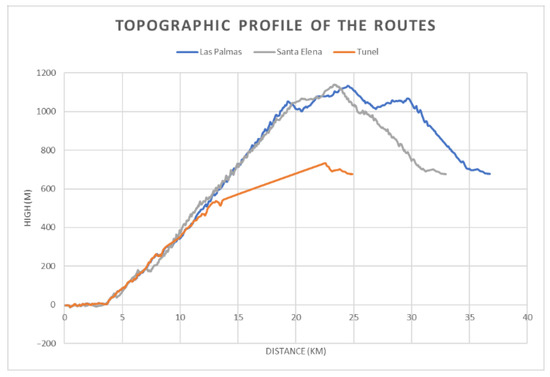
Figure 1.
Topographic profile of routes.
- Santa Elena: it is a two-lane road that is the oldest road between the two points, since it was designed at the beginning of the 20th century; it has numerous curves.
- Las Palmas: it was constructed in the second half of the 20th century and is longer than Santa Elena, but it is designed for higher speed. Half of it is a four-lane road (two lanes in each direction), and the other half is a two-lane road with fewer curves than Santa Elena.
- Tunnel: This shares the initial path of Las Palmas, but instead of going up and down hill, it crosses the mountain with a tunnel, reducing the travel time. This is known as the Eastern Tunnel (in Spanish “Túnel de oriente”).
Geographic information was obtained via global positioning system (GPS) mapping and tracking routes in light vehicles, accounting for more than 80% of the usual traffic on these routes. Figure 2 presents the three routes between Medellin (left) and the airport (right); Las Palmas is the southernmost, and Santa Elena is the northernmost.
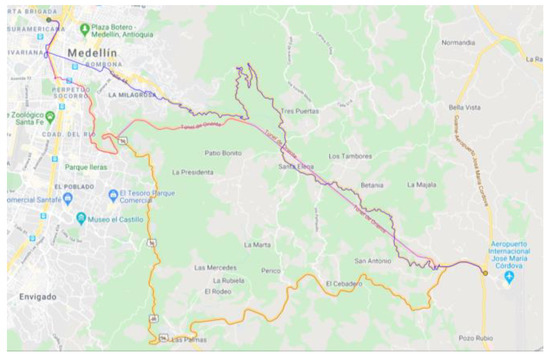
Figure 2.
Planimetry of routes.
3.2. ROA
Variations and calculations must be made for the lender to use the ROA in mezzanine debt schemes. Therefore, the lender’s cash flow concerning the possibility of becoming a shareholder is considered to be valued with real options.
Volatility is obtained using the marketed asset disclaimer method proposed by Copeland and Antikarov [44,45,46], opting for the standard cash flow deviation.
Subsequently, the valuation using the real options is considered an option CALL, where the lender can become a shareholder at any time. In case the forecast is not the best, the investor can receive the return of the debt to the cost of the initial debt (Kd) for which it was financed.
Thus, the saving value is the same investment discounted at the current value without considering the capital contributions by the lender. As already known, the value captured for each period determines the value to vary with the actual options in year zero, that is, after the investment and before the operation returns.
Finally, the option’s value comprises the difference of the captured value starting from the investment, including the amount of the risk as to the mean.
The valuation of the CALL option comprises considering the investment and return as two different perspectives, including the discount within the risk-free rate as the cost of the debt because it is the lowest income that the lender receives.
3.3. Methodology
This research proposes a model to exercise a decision option that allows lenders to become project shareholders through mezzanine financing. The three aforementioned routes with ROA for financial factors are studied in the following sustainable terms: carbon footprints valued in money and establishing a constant reduction of CO2 production per year. If the project meets a sustainable criterion, it could achieve financing with a green bond and a relation of equity/debt of 80%/20%.
The cost values used in this study refer to the project by Ruiz and Navarro [47], who take values from 2007 and project future costs using inflation in Colombia.
Historical data were extracted from the INVIAS (2017) database are used to calculate the average annual daily traffic (AADT) and annual growth rates. The data is only available on Santa Elena, and Las Palmas routes since the Tunnel was not in operation yet. Subsequently, the tunnel route values are assumed as follows. Since the Tunnel directly competes with the two previously existing ones, its AADT and annual growth rate are a weighted average of the values from the extant routes between the origin and destination under analysis. An additional 1% growth is also included owing to increasing economic activity (tourism, housing developments, and related growth activities).
The next step was to define the capacity limit for each route, which is the point at which a route collapses and becomes inefficient owing to congestion. This restricts the AADT growth within a time horizon of 20 years.
CO2 emissions were calculated for the three routes, then the two most viable routes (in terms of time and emissions) were selected to conduct a marginal analysis between them.
The monetized carbon footprint is used to calculate under a discounted cash flow value using ROA whether the lender has an opportunity to exercise the option to become a shareholder. This is indispensable for determining the daily consumption for each alternative on an annual basis, divided into fuel and energy consumption. The cost of tons of CO2 is applied, depending on the volatility of the asset and its distribution indicated in the research of Knoope et al. [48], converted to Colombian pesos (COP).
Another option to value the carbon credit price per CO2 ton is according to Colombian law 1819 of 2016, which set the carbon tax with a tariff of $15,000 COP per CO2 ton; this must be in real value for the corresponding inflation. The calculation of CO2 production for each option is as follows.
Fuel consumption is calculated using the formula proposed by Posada et al. [49], which has some independent variables obtained previously for all three alternatives: speed profile, traffic composition (for vehicle weight), and road slopes. It is noteworthy that the formula had an adjusted error of 99.97%. In addition, the estimated conversion factor of gasoline to diesel was approximately 75%. Regarding power consumption, assumptions were used for a single and typical luminaire, according to the distance between lighting and KWh consumption, along with a period of operation (from 6 a.m. to 6 p.m., in other words, 12 h), resulting in the value of daily energy consumption.
Transformation to CO2 Ton: The conversion factors for obtaining the CO2 production are governed by a methodology guide for calculating the corporative carbon footprint at the sectoral level, specifically for transport.
Climate Bonds Initiative offers a criteria series depending on the sector in which the project will be developed, and this facilitates the identification of whether the project is available to access sustainable financing. In the current case, we applied criterion 7 from the Low Carbon Land Transport and the Climate Bond Standards (Version 1) [50]. This criterion applies to all infrastructure projects (if project appraisal is available). It is defined as a strategy to reduce carbon emissions per person and kilometer traveled, linking the CO2 decrease from 2010 to 2050. Therefore, in this work a linear regression is conducted to obtain the annual decrease. This is compared using a method similar to the model being the specific case for the Tunnel route. The total reduction of CO2 per person and kilometer traveled concerning the other two routes highlights who produces the most CO2 and currently presents greater use according to traffic composition.
In the project’s structuring, it was necessary to make an average annual traffic growth forecast that considered both the investor and the debtor’s returns to become shareholders. It was essential to make a financial projection considering the project cash flow from this point. Subsequently, the valuation of the NPV that a lender would have determines whether it is appropriate to exercise the conversion option in a specific temporary space.
We obtained the maximum return value that the lender could achieve for converting and applying the right granted by mezzanine financing to consolidate the premium value. This result was found through the ROA and required the definition of the representative variables emulated within a Monte Carlo simulation to obtain project volatility. These data enabled the determination of how mezzanine financing should be valued. Through a zero-year binomial tree, the contracting of the financing must be evaluated as a call option by becoming a shareholder if the forecast or situation is favorable; otherwise, the lender receives just the interest on the cost of the debt.
4. Results and Discussion
CO2 emissions were calculated for the three routes. Figure 3 reports the results for the roundtrips (Medellin–airport–Medellin). The route with the lowest emissions is the Eastern Tunnel, which was almost a certain conclusion because it is the shortest route and avoids crossing the mountain pass. In addition, the Tunnel allows for a high and steady speed. In contrast, the route with the most emissions is Santa Elena, highlighting that this is an old curvy mountain road. Although Las Palmas is a longer route, CO2 emissions are lower than that in Santa Elena because it has few curves and can be traversed at a higher speed.
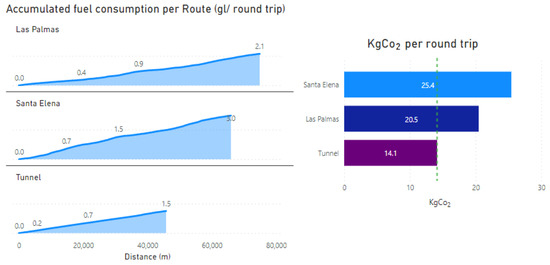
Figure 3.
Fuel consumption and CO2 emissions analyses for each roundtrip route.
As Santa Elena is an almost obsolete route, which is reflected in its CO2 emissions per trip, there is no viable possibility of constructing a capacity expansion. Therefore, to reduce CO2 production, we will only consider the Tunnel, and Las Palmas routes to value the PF and mezzanine debt scheme application.
Figure 4 illustrates a differential analysis between the Tunnel and Las Palmas routes. The emission savings from the Tunnel increase, considering the evolving AADT ratio between the two routes over time. Indeed, the Tunnel route is the most environmentally friendly alternative and meets the criteria of allowing access to financing with sustainable bonds, whereas the two other alternatives are unsuitable for financing.
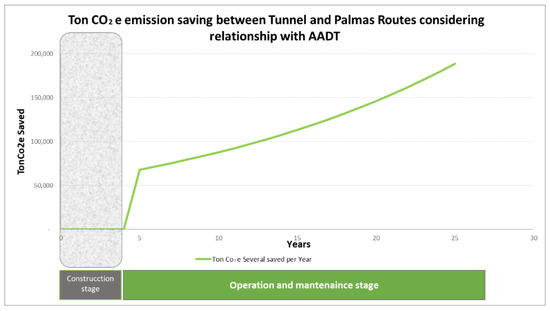
Figure 4.
CO2 emissions savings between the Tunnel and Las Palmas routes.
In addition, it is important to note that in a 25-year horizon, the Tunnel route will not collapse in its capacity to accommodate the volume of traffic, whereas the Las Palmas highway would reach its limit capacity in 12 years. Subsequently, it would be necessary to implement another project to address the lack of capacity.
FCV represents the profit granted by the conversion to a shareholder, which can only be evaluated for the Tunnel route since it is the only one financed. Table 1 presents the FCV values, including sustainable factors (carbon sale), with a conversion rate of 1 and determined for year 0. Three carbon sale scenarios are considered: (1) domestic sale, (2) international sale, and (3) no sale. In all financing scenarios, the projection is favorable, particularly when using the international sale of carbon credits that allows greater profits on investment capital

Table 1.
Financial captured value (FCV) in year 0 for the Tunnel route with sustainable factor (carbon sale scenarios); figures in million COP.
The Tunnel route data are encouraging. According to the data, the best option is based on capital expenses partial financing, with sustainable approval to access tax benefits as an application of 25% income tax per 15 after investment, if a profit strategy reduction in CO2 production could lead to increases in project recovery of 2.0% or 11.8%, for national or international sales (excluding currency exchange), respectively. It is noteworthy that including carbon credit sales revenue and the conversion option to shareholders grants more income than only the return of the discounted interest to the Kd.
Figure 5 shows how the FCV changes over time. Evidently, it increases during the initial years. However, after passing the peak around Year 7, all flows converge because the additional gain to reduce CO2 tends to be zero at the end of debt payments. It is assumed that the Las Palmas route reaches its point of collapse for traffic saturation, and therefore, traffic in the Tunnel route continues to grow.
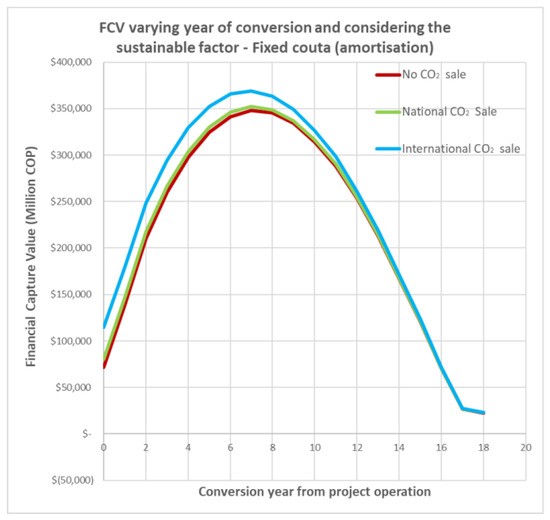
Figure 5.
Variation between the FCV and year of conversion. Figures in COP.
According to the amortization type, the variation strongly influences the FCV and the decision of the lender to become a shareholder, as shown in Figure 6. Therefore, the best option is the depreciation of the capital of constant debt, but a fixed fee is advisable if the lender wants to make a late transformation.
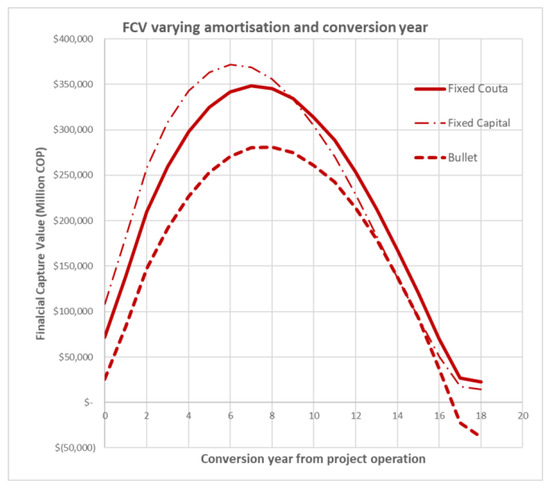
Figure 6.
Variation between the FCV and year of conversion. Figures in COP.
In Table 2, the difference in the discount in income tax from 33% to 25% is evaluated with conversion values for Years 0 and 6:

Table 2.
Results of NPV and FCV depending on the application of benefits tax to be a sustainable project (Fixed payment). Figures in Million COP.
This point demonstrates that the evolution of taxes, as tax benefits, as sustainable projects significantly impact the FCV more than the NPV of the free cash flow. If the debtor becomes a shareholder, the taxes are caused in full, and the tax savings produced by the paid interest disappear. Thus, it is advisable for an investor intending to become a shareholder to borrow under mezzanine financing.
As presented in Figure 7, the option value for a lender to become a shareholder has more value when the amortization debt is constant, and revenues from the sale of carbon credits are saved. Moreover, these values are higher in the FCV, although the volatility to use these conditions is lower than the other considerations by up to 2%.
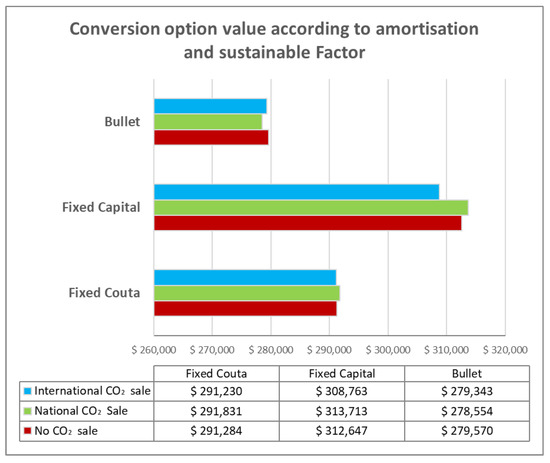
Figure 7.
Conversion option value according to amortization and sustainable factor. Figures in COP.
5. Conclusions
The FCV is the creation of value for investors in infrastructure projects. In this way, the benefits of effective capital amortization and contribution planning must be understood according to the need for their cash flows. This point could optimize financial capture without taking risks as potential shareholders, which incurs equity contributions from the project planning stage. The debt’s amortization type influences the creditor’s decision to become a shareholder. According to the simulated case, if the mezzanine debt is agreed with amortization of constant capital, the lender should exercise its right of conversion earlier than when the debt is repaid with fixed quotas to reach the maximum and optimal FCV.
The sustainability factor for a road is complex considering the parameters of the different sustainable classification systems for these infrastructure projects. Therefore, it emphasizes reducing CO2 emissions for developing countries with greater importance on sustainable development goals aimed at social and economic development.
The conversion option value in the simulated case is similar to the maximum FCV obtained in the optimized year. However, this result could only occur if the forecast of the input variables is met and the cash flow is static. Then, regardless of the variation in the inputs, the variation inflows in the project are given, so that the FCV can potentially improve more than the optimized FCV according to the year of conversion.
Further research is advisable. So far, the analysis in this work has been made from the project’s perspective; the study has been focused on quantifying the conversion option value and its incidence in the project cash flows. However, it is advisable to focus the analysis from on the lender’s perspective, so further studies should analyze option payments within the lender’s cash flow. In that case, new data related to the creditors should be obtained to determine how viable it would be for them to finance this type of project. In addition, to value a conversion option for a certain period, it is necessary to value cash flow differently for shareholders and investors.
Moreover, further studies could simulate and obtain probabilities in each FCV period higher than that of the option value to pay; this completes the valuation of the project for an investor looking to participate in the project as a lender through mezzanine debt. The most significant limitation of this study is the lack of information on similar projects that would allow for a comparison of results. Nonetheless, we find that the methodology proposed here can be easily generalized and it is suitable to be applied to similar projects across the globe. In addition, it is worth mentioning that this paper was derived from the master’s thesis of Luis Aguilar [51].
Author Contributions
Conceptualization, L.A., J.D.G.-R., and S.B.; methodology, L.A. and J.D.G.-R.; data curation, L.A.; formal analysis, L.A., J.D.G.-R., and S.B.; writing—original draft preparation, L.A. and J.D.G.-R.; writing—review and editing, S.B; supervision, J.D.G.-R. All authors have read and agreed to the published version of the manuscript.
Funding
This paper was the result of a master’s thesis from the National University of Colombia at Medellín. The Master’s Student is Luis Aguilar, while the directors are prof. Juan David González and Sergio Botero, who received funding as university employees.
Institutional Review Board Statement
This study did not require ethical approval.
Data Availability Statement
The study data are available on special request from the corresponding author.
Acknowledgments
The authors would like to thank the three anonymous reviewers for providing constructive comments and valuable suggestions.
Conflicts of Interest
The authors declare no conflict of interest.
References
- Gonzalez-Ruiz, J.D.; Arboleda, A.; Botero, S.; Rojo, J. Investment valuation model for sustainable infrastructure systems: Mezzanine debt for water projects. Eng. Constr. Archit. Manag. 2019, 26, 850–884. [Google Scholar] [CrossRef]
- Kim, K.; Cho, H.; Yook, D. Financing for a sustainable PPP development: Valuation of the contractual rights under exercise conditions for an urban railway PPP Project in Korea. Sustainability 2019, 11, 1573. [Google Scholar] [CrossRef] [Green Version]
- Liu, J.; Yu, X.; Cheah, C.Y.J. Evaluation of restrictive competition in PPP projects using real option approach. Int. J. Proj. Manag. 2014, 32, 473–481. [Google Scholar] [CrossRef]
- Ford, D.N.; Lander, D.M.; Voyer, J.J. A real options approach to valuing strategic flexibility in uncertain construction projects. Constr. Manag. Econ. 2002, 20, 343–351. [Google Scholar] [CrossRef]
- Abdel Aziz, A.M. Successful delivery of public—Private partnerships for infrastructure development. J. Constr. Eng. Manag. 2007, 133, 918–931. [Google Scholar] [CrossRef]
- Garvin, M.J.; Cheah, C.Y.J. Valuation techniques for infrastructive investment decisions. Constr. Manag. Econ. 2004, 22, 373–383. [Google Scholar] [CrossRef]
- Zhang, X. Critical success factors for public–private partnerships in infrastructure development. J. Constr. Eng. Manag. 2005, 131, 3–14. [Google Scholar] [CrossRef]
- Menheere, S.; Pollalis, S.; Huijbregts, R. Case Studies on Build Operate Transfer; Delft University of Technology: Delft, The Netherlands, 1996. [Google Scholar]
- Xenidis, Y.; Angelides, D. The financial risks in build-operate-transfer projects. Constr. Manag. Econ. 2005, 23, 431–441. [Google Scholar] [CrossRef]
- De Marco, A.; Mangano, G.; Zou, X.Y. Factors influencing the equity share of build-operate-transfer projects. Built Environ. Proj. Asset Manag. 2012, 2, 70–85. [Google Scholar] [CrossRef] [Green Version]
- Finnerty, J. Project Financing: Asset-Based Financial Engineering; Wiley: Hoboken, NJ, USA, 2013. [Google Scholar]
- Bakatjan, S.; Arikan, M.; Tiong, R.L.K. Optimal capital structure model for BOT power projects in Turkey. J. Constr. Eng. Manag. 2003, 129, 89–97. [Google Scholar] [CrossRef]
- Zhang, X. Financial viability analysis and capital structure optimization in privatized public infrastructure projects. J. Constr. Eng. Manag. 2005, 131, 656–668. [Google Scholar] [CrossRef]
- Garvin, M.J. Enabling development of the transportation public–private partnership market in the United States. J. Constr. Eng. Manag. 2010, 136, 402–411. [Google Scholar] [CrossRef]
- Bybee, R.W. Planet earth in crisis: How should science educators respond? Am. Biol. Teach. 1991, 53, 146–153. [Google Scholar] [CrossRef]
- Spackman, M. Handling Non-Monetised Factors in Project, Programme and Policy Appraisal; Grantham Research Institute on Climate Change and Environment: London, UK, 2013; pp. 1–37. [Google Scholar]
- World Commission on Environment and Development. Our Common Future; Oxford University Press: Oxford, UK, 1987. [Google Scholar]
- Egler, H.; Frazao, R. Sustainable Infrastructure and Finance: How to Contribute to a Sustainable Future; 2016; p. 41. Available online: https://www.greengrowthknowledge.org/sites/default/files/downloads/resource//Sustainable_Infrastructure_and_Finance_UNEPInquiry.pdf (accessed on 5 May 2021).
- Bhattacharya, A.; Contreras, C.; Jeong, M.; Amin, A.-L.; Watkins, G.; Silva, M. Atributos y Marco Para la Infraestructura Sostenible; N° IDB-TN-01653; IDB Group: Washington, DC, USA, 2019. [Google Scholar]
- González-Ruíiz, J.D.; Botero-Botero, S.; Duque-Grisales, E. Financial eco-innovation as a mechanism for fostering the development of sustainable infrastructure systems. Sustainability 2018, 10, 4463. [Google Scholar] [CrossRef] [Green Version]
- Arvidsson, S. Challenges in Managing Sustainable Business Reporting, Taxation, Ethics and Governance; Springer International Publishing: Cham, Switzerland, 2018. [Google Scholar]
- Shaydurova, A.; Panova, S.; Fedosova, R.; Zlotnikova, G. Investment attractiveness of ‘Green’ financial instruments. J. Rev. Glob. Econ. 2018, 7, 710–715. [Google Scholar] [CrossRef] [Green Version]
- González-Ruiz, J.D.; Arboleda, C.A.; Botero, S. A Proposal for Green Financing as a Mechanism to Increase Private Participation in Sustainable Water Infrastructure Systems: The Colombian Case. Procedia Eng. 2016, 145, 180–187. [Google Scholar] [CrossRef] [Green Version]
- Radavoi, C.N.; Bian, Y. The Asian Infrastructure Investment Bank’s environmental and social policies: A critical discourse analysis. J. Int. Comp. Soc. Policy 2018, 34, 1–18. [Google Scholar] [CrossRef]
- Diaz-Sarachaga, J.M.; Jato-Espino, D.; Alsulami, B.; Castro-Fresno, D. Evaluation of existing sustainable infrastructure rating systems for their application in developing countries. Ecol. Indic. 2016, 71, 491–502. [Google Scholar] [CrossRef] [Green Version]
- Ugwu, O.O.; Haupt, T.C. Key performance indicators for infrastructure sustainability—A comparative study between Hong Kong and South Africa. J. Eng. Des. Technol. 2005, 3, 30–43. [Google Scholar] [CrossRef]
- Umer, A.; Hewage, K.; Haider, H.; Sadiq, R. Sustainability assessment of roadway projects under uncertainty using Green Proforma: An index-based approach. Int. J. Sustain. Built Environ. 2016, 5, 604–619. [Google Scholar] [CrossRef] [Green Version]
- Boschmann, E.E.; Kwan, M.-P. Toward socially sustainable urban transportation: Progress and potentials. Int. J. Sustain. Transp. 2008, 2, 138–157. [Google Scholar] [CrossRef]
- Clevenger, C.; Ozbek, M.; Simpson, S. Review of sustainability rating systems used for infrastructure projects. In Proceedings of the 49th ASC Annual International Conference, San Luis Obispo, CA, USA, 10–13 April 2013; pp. 10–13. [Google Scholar]
- Flores, R.F.; Montoliu, C.M.; Guedella Bustamante, E. Life cycle engineering for Roads (LCE4ROADS), the new sustainability certification system for roads from the LCE4ROADS FP7 project. Transp. Res. Procedia 2016, 14, 896–905. [Google Scholar] [CrossRef] [Green Version]
- Lim, S. Framework and Processes for Enhancing Sustainability Deliverables in Australian Road Infrastructure Projects. Doctoral dissertation, Queeland University of Technology, Brisbane City, Australia, 2009. Available online: https://eprints.qut.edu.au/32053/ (accessed on 15 January 2021).
- Griffiths, K. Project sustainability management in infrastructure projects. In Proceedings of the 2nd International Conference on Sustainability Engineering and Science, Auckland, New Zealand, 21–23 February 2007. [Google Scholar]
- Luehrman, T.A. What’s it worth? A general manager’s guide to valuation. Harv. Bus. Rev. 1997, 75, 132–142. [Google Scholar] [PubMed]
- Gijsen, F. Added Value of Different Approaches of Real Options in Transportation Infrastructure Projects Decision-Making; TU Delft: Delft, The Netherlands, 2016; pp. 1–10. [Google Scholar]
- Kim, Y.; Shin, K.; Ahn, J.; Lee, E.-B. Probabilistic cash flow-based optimal investment timing using two-color rainbow options valuation for economic sustainability appraisement. Sustainability 2017, 9, 1781. [Google Scholar] [CrossRef] [Green Version]
- Ashuri, B.; Kashani, H.; Molenaar, K.R.; Lee, S.; Lu, J. Risk-neutral pricing approach for evaluating BOT highway projects with government minimum revenue guarantee options. J. Constr. Eng. Manag. 2012, 138, 545–557. [Google Scholar] [CrossRef]
- Shi, J.; Duan, K.; Wen, S.; Zhang, R. Investment valuation model of public rental housing PPP project for private sector: A real option perspective. Sustainability 2019, 11, 1857. [Google Scholar] [CrossRef] [Green Version]
- Sazonov, S.; Ezangina, I.; Makarova, E.; Gorshkova, N.; Vaysbeyn, K. Alternative sources of business development: Mezzanine financing. Sci. Pap. Univ. Pardubice Ser. D Fac. Econ. Adm. 2016, 23, 143–155. [Google Scholar]
- Jain, S. Investing in credit series: Mezzanine debt. UBS Altern. Invest. 2012, 1–15. Available online: https://ssrn.com/abstract=2102859 (accessed on 15 January 2021).
- Silbernagel, C. Mezzanine Finance; Bond Capital: Vancouver, BC, Canada, 2012; p. 8. [Google Scholar]
- Svedik, J.; Tetrevova, L. Mezzanine financing instruments as alternative sources of financing industrial enterprises. In METAL 2014, Proceedings of the 23rd International Conference on Metallurgy and Materials, Brno, Czech Republic, 21–23 May 2014; University of Pardubice: Pardubice, Czech Republic, 2014; pp. 1908–1913. [Google Scholar]
- Hartmann-Wendels, T.; Keienburg, G.; Sievers, S. Adverse selection, investor experience and security choice in venture capital finance: Evidence from Germany. Eur. Financ. Manag. 2011, 17, 464–499. [Google Scholar] [CrossRef]
- Espen-Eckbo, B.; Thorburn, K. Corporate restructuring. Found. Trends Financ. 2012, 7, 159–288. [Google Scholar] [CrossRef]
- Milanesi, G. Teoria de Opciones: Modelos Específicos y Aplicaciones Para Valorar Estrategias, Activos Reales e Instrumentos Financieros; Editorial de la Universidad Nacional del Sur: Bahía Blanca, Argentina, 2013; p. 256. [Google Scholar]
- Lamothe, P.; Mendez, M. Opciones Reales: Métodos de Simulación y Valoración; Ecobook-Editorial del Economista: Madrid, Spain, 2013. [Google Scholar]
- Copeland, T.; Antikarov, V. Real Options: A Practitioner’s Guide; Texere: New York, NY, USA, 2001. [Google Scholar]
- Ruiz, J.; Navarro, J. Valoración y análisis de riesgo para concesiones viales en Colombia marco teórico y desarrollo. Undergraduate’s Thesis, Uniandes, Bogotá, Colombia, 2010. Available online: https://repositorio.uniandes.edu.co/handle/1992/14362 (accessed on 15 January 2021).
- Knoope, M.M.J.; Ramírez, A.; Faaij, A.P.C. The influence of uncertainty in the development of a CO2 infrastructure network. Appl. Energy 2015, 158, 332–347. [Google Scholar] [CrossRef]
- Posada, J.; Sarmiento, I.; Correa, A. Consumo de Combustible en Camiones Según Peso del Vehículo y Otras Variables; Universidad Nacional de Colombia: Bogotá, Colombia, 2014. [Google Scholar]
- Climate Bonds Initiative. Low Carbon Land Transport and the Climate Bonds Standard (Version 1.0)—Background Paper to Elegibility Criteria. 2017. Available online: https://www.climatebonds.net/files/files/standards/Land%20transport/Land%20Transport%20Criteria%20Version%201%20Feb%202017.pdf (accessed on 10 July 2021).
- Aguilar, L. Modelo de Decisión de Ejercicio de Una Opción de Accionista en Proyectos de Infraestructura Sostenible Bajo un Esquema de Financiación Tipo Mezzanine. Master’s Thesis, Universidad Nacional de Colombia, Bogotá, Columbia, 2020. Available online: https://repositorio.unal.edu.co/handle/unal/78803 (accessed on 15 January 2021).
Publisher’s Note: MDPI stays neutral with regard to jurisdictional claims in published maps and institutional affiliations. |
© 2022 by the authors. Licensee MDPI, Basel, Switzerland. This article is an open access article distributed under the terms and conditions of the Creative Commons Attribution (CC BY) license (https://creativecommons.org/licenses/by/4.0/).